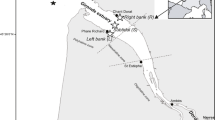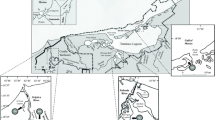Abstract
We used carbon stable isotope and stomach content analyses to test whether snub-nosed garfish, Arrhamphus sclerolepis (Hemiramphidae), in the extensive artificial urban waterways of southeast Queensland, Australia, rely on autotrophic sources different to those in natural wetlands. Carbon isotope values of A. sclerolepis were similar to those in previous investigations, with enriched values in natural habitat (mean = −13.9‰, SE=0.6) and depleted values (−19.1‰, 0.1) in artificial habitat. A. sclerolepis in natural habitat consumed large amounts of seagrass during the day and night, and at night also ingested small quantities of crustacean prey. In artificial habitat, A. sclerolepis consumed macroalgae during the night and switched to invertebrates (terrestrial ants) in the day. Values of δ15 N in all the fish were 3–8‰ more enriched than sources. Mathematical modelling of feasible source mixtures showed that in natural habitat the bulk of the dietary carbon is obtained from seagrass, but the nitrogen is obtained from animal prey. In artificial habitat, carbon is obtained from a mixture of macroalgae and animals. We could not determine the nitrogen sources in artificial habitat of A. sclerolepis since, even after accounting for trophic fractionation of δ15 N, the values were outside the range of potential sources. If the types of animals ingested vary over time, perhaps one or more types of animal important in the provision of nitrogen was not sampled during the study. This study demonstrates that not only does A. sclerolepis occur in both artificial and natural habitats, but it uses the same strategy of bulk herbivory with the inclusion of smaller amounts of animal prey. This understanding of how ecological processes support fisheries production in artificial habitat improves the overall understanding of the effects of urbanisation on coastal food webs.




Similar content being viewed by others
References
Blaber SJM, Blaber TG (1980) Factors affecting the distribution of juvenile estuarine and inshore fish. J Fish Biol 17:143–162
Bunn SE, Loneragan NR, Kempster MA (1995) Effects of acid washing samples on stable isotope ratios of C and N in penaeid shrimp and seagrass: implications for food web studies using multiple stable isotopes. Limnol Oceanogr 40:622–625
Carseldine L, Tibbetts IR (2005) Dietary analysis of the herbivorous hemiramphid Hyporhamphorus regularis ardelio: an isotopic approach. J Fish Biol 66:1589–1600
Cohen JE, Small C, Mellinger A, Gallup J, Sachs J (1997) Estimates of coastal populations. Science 278:1211–1212
Connolly RM (2003) Differences in trophodynamics of commercially important fish between artificial waterways and natural coastal wetlands. Estuar Coast Shelf Sci 58:929–936
Connolly RM, Hindell JS, Gorman D (2005) Seagrass and epiphytic algae support the nutrition of a fisheries species, Sillago schomburgkii, in adjacent intertidal habitats. Mar Ecol Prog Ser 286:69–79
Gaston TF, Kostoglidis A, Suthers IM (2004) The 13C, 15N and 34S signatures of a rocky reef planktivorous fish indicate different coastal discharges of sewage. Mar Freshw Res 55:689–699
Guest MA, Connolly RM, Loneragan NR (2004) Within and among-site variability in δ13C and δ15N for three estuarine producers, Sporobolus virginicus, Zostera capricorni, and epiphytes of Z. capricorni. Aquat Bot 79:87–94
Hesslein RH, Hallard KA, Ramlal P (1993) Replacement of sulfur, carbon and nitrogen in tissue of growing broad whitefish (Coregonus nasus) in response to a change in diet traced by δ34S, δ13C and δ15N. Can J Fish Aquat Sci 50:2071–2076
Jennings S, Reñones O, Morales-Nin B, Polunin NVC, Moranta J, Coll J (1997) Spatial variation in the 15N and 13C stable isotope composition of plants, invertebrates and fishes on Mediterranean reefs: implications for the study of trophic pathways. Mar Ecol Prog Ser 146:109–116
Kinch JC (1979) Trophic habits of the juvenile fishes within artificial waterways—Marco Island, Florida. Contrib Mar Sci 22:77–90
Klumpp DW, Nichols PD (1983) Nutrition of the southern sea garfish Hyporhamphus melanochir: gut passage rate and daily consumption of two food types and assimilation of seagrass components. Mar Ecol Prog Ser 12:207–216
McCutchan J, Lewis W, Kendall C, McGrath C (2003) Variation in trophic shift for stable isotope ratios in carbon, nitrogen and sulphur. Oikos 102:378–390
Maxted JR, Eskin RA, Weisberg SB, Chaillou JC, Kutz FW (1997) The ecological condition of dead-end canals of the Delaware and Maryland coastal bays. Estuaries 20:319–327
Melville AJ, Connolly RM (2003) Spatial analysis of stable isotope data to determine primary sources of nutrition for fish. Oecologia 136:499–507
Odum EP (1984) The status of three ecosystem level hypotheses regarding salt marsh estuaries: tidal subsidy, outwelling and detritus based food chains. In: Kennedy VS (ed) Estuarine perspectives. Academic, New York, pp 485–495
Oliver DL (1998) The importance of insects and lerp in the diet of juvenile regent honeyeaters, Xanthomyza phrygia: implications for the conservation of an endangered woodland bird. Wild Res 29:409–417
Peterson BJ, Fry B (1987) Stable isotopes in ecosystem studies. Annu Rev Ecol Syst 18:293–320
Phillips DL, Gregg JW (2001) Uncertainty in source partitioning using stable isotopes. Oecologia 127:171–179
Pinnegar JK, Polunin NVC (2000) Contributions of stable isotope data to elucidating food webs of Mediterranean rocky littoral fishes. Oecologia 122:399–409
Robertson AI, Klumpp DW (1983) Feeding habits of the southern Australian garfish Hyporhamphus melanochir: a diurnal herbivore and nocturnal carnivore. Mar Ecol Prog Ser 10:197–201
Rose MD, Polis GA (1998) The distribution and abundance of coyotes: the effects of allochthonous food subsidies from the sea. Ecology 79:998–1007
Schlacher TA, Wooldridge TH (1996) Origin and trophic importance of detritus: evidence from stable isotopes in benthos of a small temperate estuary. Oecologia 106:382–388
Shattuck S (1999) Australian ants: their biology and identification. CSIRO Publishing, Australia
Szepanski MM, Ben-David M, Van Ballengerghe V (1999) Assessment of anadromous salmon resources in the diet of the Alexander Archipelago wolf using stable isotope analysis. Oecologia 120:327–335
Tibbetts IR (1991) The trophic ecology, functional morphology and phylogeny of the Hemiramphidae (Beloniformes). PhD Thesis, University of Queensland
Tibbetts IR (1997) The distribution and function of mucous cells and their secretions in the alimentary tract of Arrhamphus sclerolepis krefftii. J Fish Biol 50:809–820
Vizzini S, Mazzola A (2002) Stable carbon and nitrogen ratios in the sand smelt from a Mediterranean coastal area: feeding habits and effect of season and size. J Fish Biol 60:1498–1510
Wainright SC, Weinstein MP, Able KW, Currin CA (2000) Relative importance of benthic microalgae, phytoplankton and the detritus of smooth cordgrass Spartina alterniflora and the common reed Phragmites australis to brackish-marsh food webs. Mar Ecol Prog Ser 200:77–91
Winning MA, Connolly RM, Loneragan NR, Bunn SE (1999) 15N enrichment as a method of separating the isotopic signatures of seagrass and its epiphytes for food web analysis. Mar Ecol Prog Ser 189:289–294
Acknowledgements
We appreciate field assistance from M. Brickhill, R. Drinkwater, R. Duffy, D. Gorman, B. Hays and D. Jan. We thank R. Diocares for isotope analysis and J. Oakes for comments on the manuscript. This study was funded by Gold Coast City Council through the Griffith Centre for Coastal Management, and was conducted under Animal Ethics Approval EAS03/02/aec.
Author information
Authors and Affiliations
Corresponding author
Additional information
Communicated by G.F. Humphrey, Sydney
Rights and permissions
About this article
Cite this article
Waltham, N.J., Connolly, R.M. Trophic strategies of garfish, Arrhamphus sclerolepis, in natural coastal wetlands and artificial urban waterways. Marine Biology 148, 1135–1141 (2006). https://doi.org/10.1007/s00227-005-0154-7
Received:
Accepted:
Published:
Issue Date:
DOI: https://doi.org/10.1007/s00227-005-0154-7




